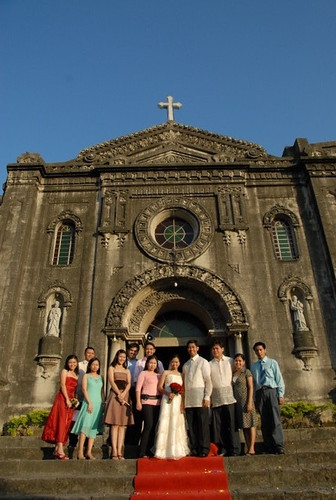
I was born in Santa Ana, Manila but I have spent most of my childhood in Makati, this wonderful places has become part of who I am - I've always felt priviledged for having them as my home!
Unfamiliar to many, Macati have a incredibly rich historic past. I was reminded to brush up with the local history upon attending a wedding of a friend. The links from the past is in all places, we'll just have to look closer.
Written history of Makati started when Lopez de Legaspi arrived. Macati was tagalog, 'waning tide', there were many accounts of the origin of the town's name, the most accepted among researchers since it was cited that de Legazpi himself gave it. It was once part of the domain of a Lakan, seated in what is now Santa Ana.
The towns of my childhood connected.
This church was once the hub of Spanish management, the quest to put the local inhabitants in order to put up a town of it proved to be difficult. Inhabitants resided close to the river, they were unwilling to be uprooted for obvious reasons. The indigents were tentative to convert to Christianity, a frequent problem faced at that time by the religious and the early pioneers. Reducing the town into submission was a tall order, one could only imagine the difficult plight of the indigents, people who possess no knowledge of the world that exist outside their known environment. In the end, Christianity has won them - so if the end justify the process used, one could accept history as it is.
Between 1578 to 1670, Macati was a visita under the district of Santa Ana de Sapa under the jurisdiction of the Franciscan De Alfaro. San Pedro de Makati, as it was known to honor the patron saint.
Makati was a marshland then, it was auctioned for P1400 in 1589, a retired Spanish army who made his fortune in the galleon trade once owned this modern city. This man, Capitan de Brito a known royalist and a devout Catholic directly took steps to expedite the catholization of the locals. Providing the religious a fine hand in evangelizing the inhabitants, de Brito now an unknown name, without even a esquinita name after him, once owner of what we now call our nation's financial center.
The Augustinian's are credited for bringing Macati 'under the bells'. The iglesia of Nuestra Señora de Gracia was originally made of bamboo and palm, the only accessible construction materials at the early days of colonization. In 1601a convent was built. The earnings of the land provided the resource to build stronger foundations with more solid materials, construction was officially finished in 1629.
The Church also served as a refuge for the orphans of the 1882 cholera epedemic.
Fortunately, the church was spared during WWII but it had been damaged by earthquakes of 1645, 1658, 1754 and 1863. the convent and the church was damaged during the American wars in 1898 but was repaired again the years that followed.
Upon entering the church, I could smell the old stone and the burning candles. It was fair in dimension, much of its aged interior was left as it was built. The Pasig river was close by so one can observe the murky and polluted waters of what was once the source of living of the original inhabitants of Macati.
The nearby neighbourhood is a typical suburb, overpopulated and polluted. The bridge is also visible, the huge Ads along the EDSA providing an unlikable background.
Being in this place, is like being in a time capsule. You could see the old and get lost in the world of beauty and madness, times that shaped our nation, the beauty of our people and our religion, culture and heritage, while on the outside you could visibly view the modernity of the times and the unpleasant spectacle it produced.



What's this? EWTN?
ReplyDeleteThis is one of the churches in Manila (Makati) that we frequently visit especially when it holds traditional church events. Last Holy Week we attended a special mass called Blessing of the Fire and Water (not sure if that's accurate). Lights were turn off. Interior of the church is pitch black until a single candle passes the flame from one candle to candle. until tiny sparks illuminate the dark interior of the church. It was very dramatic.
ReplyDeleteI heard of it but unfortunately never in my life have I attended. Lucky you :)
ReplyDeleteIts a strange old ritual - but very charming.
"What’s this? EWTN?"
ReplyDeleteMr. Antiporda, if you're looking for something which you are expecting to probably tick off your sarcasm, this is not the proper forum for you. Your, uh, "question" doesn't even rate you among the finest men of letters who have mastered literary smart-aleckiness.
Go look for trouble in other areas of the netosphere, my friend, because this site is not out to harm you.
I originally responded to mr or ms Antiporda, I retracted because as i was thinking - he/she must be, just trying to make fun and get a good laugh!
ReplyDeleteim giving him/her the benifit of the doubt. peace reigns :)